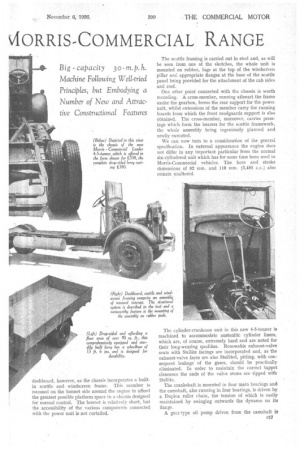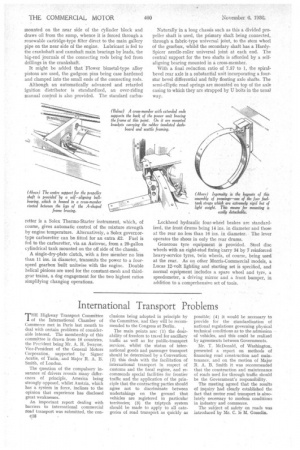NEW LEADER 4-5-TONNER IN
Page 54

Page 55

Page 56

If you've noticed an error in this article please click here to report it so we can fix it.
vi ORRIS-COMMERCIAL.RANGE NEW models do not emanate in great profusion from the works of Morris Commercial Cass, Ltd., Adder leyPark, Birmingham, 8, but when this company does decide to market a new proposition the vehicle concerned usually embraces a host of items of outstanding interest. This is true of a new model which we are, this
week, able to announce —a 4-5-ton goods chassis, selling at the moderate price of £330, the cost of the complete drop-sided lorry. with normal equipment being £380.
-Although no sweeping changes from laccepted Morris-Commercial practice are immediately . apparent. :there are, nevertheless, .many, .important and far-reaching innovations in the detail work. The aim of these improvements is to afford the maximum amount of service with a minimum amount of attention. A semi-official slogan to the effect that the company desires to "sell transport rather than trucks" aptly sums up the situation.
Actually, most of the new features concern the power unit, in which special cylinder liners, Stellited valve seats and so forth assist in the maintenance of tune over long periods, whilst in matters concerning bearing sizes and the like the new design is generously equipped on a size-for-load basis.
With a wheelbase of 13 ft. 6 ins., the overall length of the chassis works out at 20 ft. 81 ins., whilst with a rear track of 5 ft. 5 ins, the overall width amounts to 6 ft. 10 ins. The standard lorry is 14 ft. long and 6 ft. 7 ins. wide between the uprights, so that a useful platform area of over 90 sq. ft. is available.
c16 T h e well known frame design with long A-shaped central bracing is used and, apart from stating that this component has robustness as a prominent characteristic, no further comment is necessary.
There is an important point connected with the assembly of the dashboard, however, as the chassis incorporates a builtin scuttle and windscreen frame. This member is recesSed on the bonnet side around the engine to afford the greatest possible platform space in a chassis designed for normal control. The bonnet is relatively short, but the accessibility of the various components connected With the power unit is not curtailed.
The scuttle framing is carried out in steel and, as will be seen from. one of the sketches, the whole unit is mounted on rubber, lugs at the top of the windscreen pillar and appropriate flanges at the base of the scuttle panel being provided for the attachment of the cab sides and roof.
One other point connected with the chassis is worth recording. A cross-member, running athwart the frame under the gearbox, forms the rear support for the powet unit, whilst extensions of the member carry the running boards from which the front mudguards support is also obtained. The cross-member, moreover, carries pressings which form the bearers for the scuttle framework, the whole assembly being ingeniously planned and neatly executed.
We can now turn to a consideration of the general specification. In external appearance the engine does not differ in any important particular from the normal six-cylindered unit which has for some time been used in Morris-Commercial vehicles. The bore and stroke dimensions of 82 mm. and 110 mm. (3,485 c.c.) also remain unaltered.
The cylinder-crankcase unit in this new 4-5-tonner is machined to accommodate austenitic cylinder liners, which are, of course, extremely hard and are noted for their long-wearing qualities. Renewable exhaust-valve seats with Stellite facings are incorporated and, as the exhaust-valve faces are also Stellited, pitting, with consequent leakage of the gases, should be practically eliminated. In order to maintain the correct tappet clearance the ends of the valve stems are tipped with Stelae.
The crankshaft is mounted in four main bearings and the camshaft, also running in four bearings, is driven by a Duplex roller chain, the tension of which is easily maintained by swinging outwards the dynamo on its flange.
A gear-type oil pump driven from the camshaft is c17
mounted on the near side of the cylinder block and draws oil from the sump, whence it is forced through. a renewable cartridge-type filter direct to the main gallery pipe on the near side of the engine. Lubricant is fed to the crankshaft and camshaft main bearings by leads, the big-end journals of the connecting rods being fed from drillings in the crankshaft.
It might be added that Flower bimetal-type alloy pistons are used, the gudgeon pins being case hardened and clamped into the small ends of the connecting rods.
Although an automatically advanced and retarded ignition distributor is standardized, an over-riding manual control is also provided. The standard carbu retter is a Solex Thermo-Starter instrument, which, of course, gives automatic control of the mixture strength by engine temperature. Alternatively, a Solex governortype carburetter can be fitted for an extra £2. Fuel is fed to the carburetter, via an Autovac, from a 20-gallon cylindrical tank mounted on the off side of the chassis.
A single-dry-plate clutch, with a free Member no less than 11 ins, in diameter, transmits the power to a fourspeed gearbox built unitwise with the engine. Double helical pinions are used for the constant-mesh and thirdgear trains, a dog engagement for the two highest ratios simplifying changing operations. Naturally in a long chassis such as this a divided propeller shaft is used, the primary shaft being connected, through a fabric-type universal joint, to the stem wheel of the gearbox, whilst the secondary shaft has a HardySpicer needle-roller universal joint at each end. The central support for the two shafts is afforded by a selfaligning bearing mounted in a cross-member.
With a final reduction ratio of 7.57 to 1, the spiralbevel rear axle is a substantial unit incorporating a fourstar bevel differential and fully floating axle shafts. The semi-elliptic road springs are mounted on top of the axle casing to which they are strapped by U bolts in the usual way.
Lockheed hydraulic four-wheel brakes are standardized, the front drums being 14 ins, in diameter and those at the rear no less than 16 ins, in diameter. The lever operates the shoes in only the rear drums.
Generous tyre equipment is provided. Steel disc wheels with an eight-stud fixing 'carry 34 by 7 reinforced heavy-service tyres, twin wheels, of course, being used at the rear. As on other Morris-Commercial models, a Lucas 12-volt lighting and starting set is specified, and normal equipment includes a spare wheel and tyre, a speedometer, a driving mirror and a front bumper, in addition to a comprehensive set of tools.












































































































